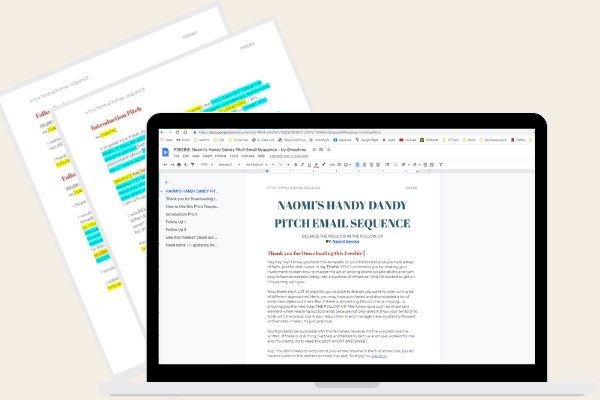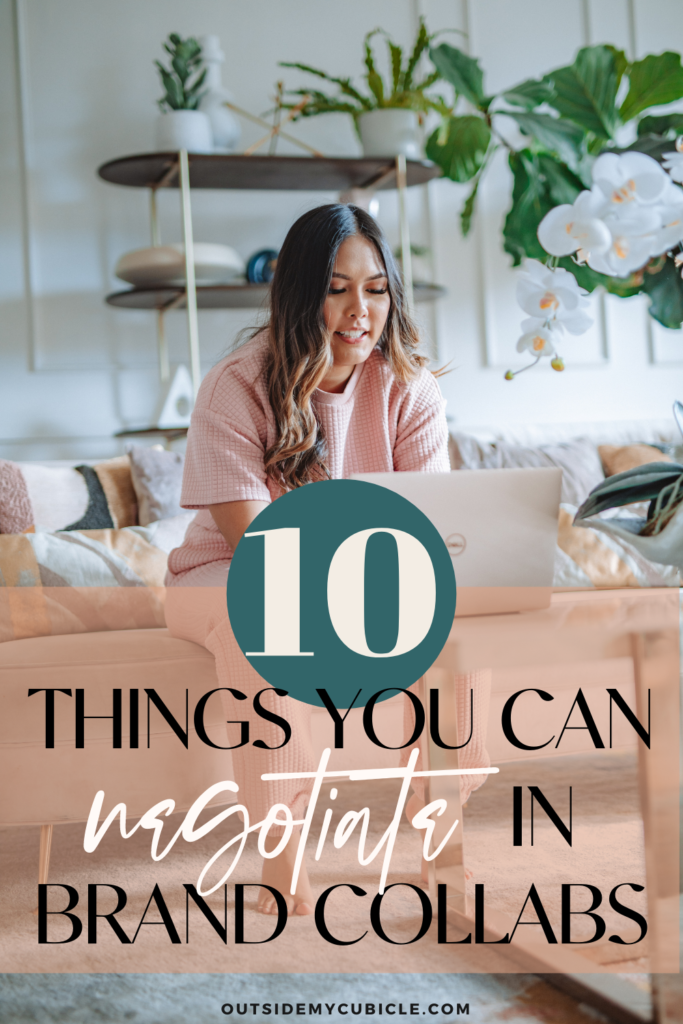blog
the

category
10 Savvy Ways You Can Negotiate Influencer Brand Collaborations
Mastering how to negotiate influencer brand collaborations is so important if you want to have a lucrative, long-term career as an influencer or creator. Knowing what you can work out in a partnership, so that it is mutually beneficial between you and the brand you are working with
will enable you to charge a premium rate for all of your brand collaborations for the least amount of work possible.
When I got started as an influencer, I wasn’t even aware that I could negotiate influencer brand collaborations. I thought that I just had to accept the terms from the first offer. But the more I realized the actual value of my craft (and how much time it took to produce branded content), I learned how to stand up for my work. After years of practice, I’m now able to take on less partnerships to make room for creating other content (like my Instagram tips for influencers) but still make more money on brand collaborations each year.

10 Savvy Ways You Can Negotiate Influencer Brand Collaborations
1. Deliverables
Outside of negotiating rates, deliverables are usually the most common way to negotiate influencer brand collaborations. Depending on the budget the brand is willing to offer (or the value of the product or service if it’s a gifted collaboration), you can either add or remove deliverables to match your rates.
For example, let’s say a brand asks you for
- 1 x IG Post
- 1 x IG Stories
- 1 x IG Reels
and your rate for the deliverables is $2,500. The brand can only afford to offer you $1,500. You can counter the offer by lowering the deliverables with two options:
- Option A: 1 x IG Post and IG Stories, or
- Option B: 1 x IG Reels and a repost of the Reels on Stories
2. Usage Rights
Content usage rights are when a brand wants to repurpose your content outside of your platform. Some usage rights can include:
- reposting your content on the brand’s social media channels
- using the content on their website as user-generated content (UGC) or as a branding material
- repurposing your content to create paid media (ads, whitelisting, dark posting)
- using the content for print (marketing materials, billboards, branding material, etc.)
If any of the above is included in your partnership contract, you must ALWAYS charge an additional fee for a brand to get content usage rights. If they cannot accommodate the cost from their fixed influencer marketing budget, you may ask them to remove it from the contract.
PRO TIP: If there’s a brand who wants to repurpose your content (if they left you a comment, DM, or email), make sure to let them know it costs a fee to do so.
3. The Value of Your Real Estate/Your Endorsement
One of the most lucrative ways you can negotiate influencer brand collaborations is by knowing the value of your real estate, or the value of your endorsement. A few years ago, brands would only place value on your real estate based on your follower count. But because brands are realizing that many creators are doctoring their audience size by buying followers, they are measuring the value of your real estate in other ways. The most obvious way is your engagement rate. While there are websites that calculate this, they’re not exactly as accurate as doing this yourself:
- Overall Engagement rate = Average (Likes + Comments + Saves + Shares) of your last X posts / followers
- Engagement rate per post = (Likes + Comments + Saves + Shares) / accounts reached
Another way to measure the value of your real estate is the quality of your influence, and sometimes that is not seen through numbers. It’s the relationships you have with your followers in the DMs. It’s the quality of your conversations in the comments. It’s how your audience interacts with your stories or your lives. It’s your ability to drive sales. You can discuss this with the brand by email, or presenting this information on your media kit.
If you’re a small creator, don’t underestimate the value of your real estate. QUALITY is always better than QUANTITY! If your engagement rate or reach is higher than creators (Later and Fohr have a wonderful article on this) with the same followers or more, you can 100% negotiate influencer brand collaborations with this by charging more money.
4. Exclusivity
Exclusivity is when you are not allowed to work with a brand’s competitors for a period of time. So when there is an exclusivity clause in your contract, think about how much work you could potentially lose for working with a brand exclusively. This is a good opportunity for you to negotiate a premium rate (or remove if they can’t afford it), but not all brands will have the same effect.
For example, if you are a beauty blogger and you work with a lot of beauty brands, working exclusively with one brand could get you to miss out on opportunities to work with competitors or similar brands. But if it’s a mattress brand that asks you to be exclusive for 1 year, it doesn’t really affect your business because there’s a slim chance that you’ll need to change mattresses within that year.
PRO TIP: Ask your brand client to specifically write down who they consider competitors so you know whether or not you are violating your contract.
5. Deadline
In the influencer industry, you are the contractor, and the brand is your client. I spent 10 years in the engineering industry before I became a full-time creator. I wasn’t just a design engineer, but I was a trained project manager. And every time our clients want a quick turnaround on deliverables (anything less than 7-10 business days), we include a rush fee. This is normal in the corporate world, so it shouldn’t be any different in the influencer world.
Many brands take advantage of the fact that a lot of influencers don’t know that a rush fee is normal for expedited jobs and will get very demanding of getting the work done on their timeline without properly compensating for the quick turnaround. So a negotiation tip?
If a brand wants their assets faster than the standard 7-10 business day rule, you can absolutely add a rush fee.
An example for this would be the holidays (where they’re trying to gain business from the Christmas rush), or Black Friday.
You can also negotiate the timeline if the deadline doesn’t work for you (for example: if you work a full-time job and only have time on the weekends to create content, or if you are on maternity leave).
6. Your Other Platforms or Best Services
In the world of negotiation, it’s never a bad idea to upsell, especially if you know the brand will get really good value from what else you have to offer. Chances are, you know what your strengths are as a content creator and influencer, you know what kind of content will maximize potential reach for the brand, and you know what will get your audience the most excited.
Here are a few examples:
- If a brand asks you for a TikTok, and you also have an audience on Instagram, you can upsell to repurpose the same video on Reels for additional exposure
- If a hotel asks you for posts and stories on Instagram, you can upsell to create a blog post and some Pinterest pins because the shelf life exceeds that of Instagram’s
- If a brand only asks for a post and stories on Instagram, you can ask the brand if they would also like some photography (or video) assets for their own marketing
7. The Demand for Seasonal Content
If you’ve worked in paid brand collaborations, you know that campaigns come in waves throughout the year, and that’s why landing brand partnerships isn’t always constant. Marketing campaigns always revolve consumer habits, so it’s important to leverage the demand for marketing on certain times of the year and negotiate influencer brand collaborations during demanding seasons.
The highest demand when casting influencers in campaigns is the holiday season. It usually starts with back to school, then Halloween, then Black Friday, then Christmas, then the last wave: the New Year. Typically the height of this season is from Black Friday through Christmas, so brands will have an increased demand to hire influencers and content creators, so this is an opportunity for you to negotiate a higher rate for that said demand (especially if it’s a rush job, like point number 5).
8. Payout Terms
Another nifty way to negotiate influencer brand collaborations is to work out the payout terms. Depending on the brand, they will have standard payout times for their influencers. They can pay a Net-30 (30 days after receipt of invoice), or Net-60 (60 days after receipt of invoice). Some brands will pay immediately. This is something you can discuss with the brand and something that can be negotiable, especially when there’s a high demand like the holidays.
Another way you can negotiate payout terms is how the brand sends payment. Payment can be in a form of a check, a bank transfer or Paypal. So before signing the contract, make sure you get the payment terms in writing from the brand so you’re not responsible for any fees upon payment. Otherwise, make sure you add this processing fee on your invoice or your rate (for example, as of August 2, 2021, Paypal’s processing fee is 3.49% + $0.49).
9. Whitelisting, Dark Posting
Whitelisting is when the brand creates an ad with a post that lives on your feed on the Facebook Ad Manager backend (you would usually give them access). Dark posting is when the brand creates an ad using your account on the Facebook Ad Manager backend (you would usually give them access), but the post doesn’t live on your feed, and you won’t have to post to promote.
It’s very important when you negotiate this in influencer brand collaborations to know exactly how long the brand is putting ad spend on your content and to get that in writing. Think about how much the brand is driving sales from your endorsement, and how much work you can potentially lose if a competitor wants to work with you and your ad is still running.
10. Asset Revisions
Asset revisions are one of the negotiation tips that often gets overlooked, but it is quite an important one, especially if you come across picky brand clients. Because I’ve been doing brand partnerships for so long, most of my collaborations will micro revisions to none at all. I like to give brands 1 to 2 (sometimes I won’t even grant 2) rounds of revisions. This will make sure that I’m setting my boundaries and that the brand values the time I spend in creating content, especially when they’re more complex productions like video or a travel project.
BONUS: The Value of The Product or Service
Another way you can negotiate influencer brand collaborations, especially if the brand can’t meet you in monetary compensation, is to negotiate the face or trade value of the product or service. For example, if your rate for partnership is $1,000 and you’re working with a grocery brand can only offer $600, you can ask the brand to increase the value of the products they send you, or give you a gift card to spend at their store to make up for the remainder.
Stop Leaving Money on the Table when You Negotiate Influencer Brand Collaborations
Negotiation takes practice. The more you exercise it like a muscle, the more you’ll build your confidence to know where you draw the line on what’s mutually beneficial in the partnership. So make sure you keep these things in mind in order to maximize what you can leverage in a partnership so you can stop leaving money on the table.
FEELING LOST ON WHAT TO SAY WHEN YOU PITCH TO BRANDS?
Download my FREE Handy Dandy Pitch Email Sequence

Learn the simplest method for you to reach out to brands you want to work with, and increase that response rate by up to 40%! It’s the exact email template sequence I use for myself and the influencers I manage… free of charge!
SAVE THIS POST!

YOU WANT TO WORK WITH BRANDS AND BE ON DEMAND...
ready to increase
in your pitches?
conversions
Download my Handy Dandy Pitch Email Sequence to learn the simplest method for you to reach out to brands you want to work with, and increase that response rate by up to 72%!
